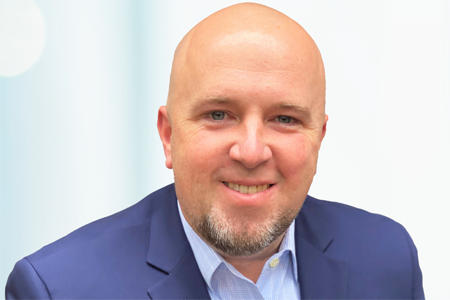Drug Discovery And Development, Powered By Physician Intelligence

By Ben Comer, Chief Editor, Life Science Leader
Nuvalent CEO James Porter doesn’t eschew artificial intelligence – as a medicinal chemist, his team of drug discovery and development scientists rely on machine learning and computational design software, such as tools from Schrödinger and Chemical Computing Group’s Molecular Operating Environment (MOE). But he also doesn’t tout AI when telling the company’s story to potential investors.
A small molecule start-up only six years old, Cambridge-based Nuvalent is one of the exceedingly few companies to IPO in 2021 and grow its share prices by more than 250% since then. In speaking with Porter about the company’s funding approach and small molecule development candidates — two “parallel” lead programs targeting ROS1+ and ALK+ mutations, respectively, in non-small cell lung cancer (NSCLC), plus a HER2+ NSCLC candidate “poised to start clinical development” — two things stuck out as essential to the company’s performance so far.

Unfortunately, “it wasn’t the best-in-class drug we had envisioned,” says Porter. “It was probably good enough for clinical development, but we made the difficult decision, as a young company still in stealth mode, to put our lead program on the shelf.” Making a decision like that, “you wonder if you’re still going to be a company” afterward, notes Porter. Retrospectively, it was “one of the best decisions we ever made,” because it allowed the company to keep pushing forward on the ROS1+ and ALK+ candidates, and to introduce a new HER2 program.
Physician Intelligence Is A Critical Input
The second item that stuck out to me as essential to Nuvalent’s success to date is the DIY physician collaboration model Nuvalent used to directly align its discovery and development functions with specific unmet needs. That physician collaboration model is related to the company’s decision to shelve its original lead candidate; physician input is how Nuvalent set the bar for continued development. Nuvalent began with specific targets in mind, and could have done an exhaustive review of the existing scientific literature in an attempt to ascertain the limitations of currently available therapies. “But no one would know better than the physicians who had worked on those therapies, and are treating those patients,” says Porter. “We went straight to the physicians, hat in hand.” Porter and his team contacted physicians and explained that Nuvalent was a brand new company in stealth mode, and that it hoped to solve particular issues associated with particular therapeutic targets. Physicians were asked, “What can you share with us that will guide our approach?” says Porter.
Those insights were gathered first from physicians in Nuvalent’s backyard: oncologists at Mass General Cancer Center and Dana Farber Cancer Institute. Describing a conversation with a team at Mass General Hospital, Porter says Nuvalent wondered if, given the fact that five drugs had already been approved in the ALK+ space, a sixth drug was even needed. The physicians explained, per Porter, that there are actually just two buckets of drugs for these patients – Alecensa (alectinib) as a frontline therapy, after which patients can progress with ALK mutations, or CNS disease. For those patients, Lorbrena (lorlatinib) is the only drug that works. However, patients that progress on those sequential therapies can develop ALK compound mutations, at which point none of the five available therapies are effective.
The physicians reviewed patients in their databases to provide detail on the number of patients treated, whether their cancers progressed, and the reasons why, says Porter. “We used those [physician identified] resistance mutations in our [drug discovery] optimization funnel, which told us our drug would need to cover at least all of those mutations that have been seen, and it also identified the immediate medical need where nothing is working.” Additionally, Nuvalent learned about cognitive side effects leading to patient management challenges for physicians. “We realized that If we could solve all of those issues with chemistry, we would potentially have a better second-line drug than lorlatinib, and a better frontline drug than alectinib … we think we have a compound now that solves for each one of those needs,” says Porter.
“It wasn’t like these physicians were rooting for Nuvalent,” explains Porter. “They just want better options for patients.” As Nuvalent made progress, the company shared updates with the physicians they had engaged, which built goodwill, and led to additional connections to other physicians. “They helped us make connections to their colleagues across academia, proactively, and sometimes at our request,” says Porter. “Now we are on those physicians’ radars, and they reach out with new ideas, based on their experiences treating patients.”
Results Matter More Than Process
Porter says investors often ask about the company’s “special sauce,” or whether Nuvalent’s scientists are better than scientists at other companies developing new therapies. “I tell them no, there are great scientists everywhere. But we are very disciplined, and laser focused on the problems we’ve heard directly from physicians who treat these patients,” says Porter. “We are resilient in going after those problems, and we hold ourselves accountable to only putting forward drug candidates that solve the challenges they’ve outlined for us.”
Although Nuvalent “uses all the computational tools available,” the company doesn’t want to be judged by the tools they use, only the results. “Here is the solution we came up with, judge us by the data, not the process,” says Porter. “Often it’s a combination of using the latest computational tools, and the creativity and innovation of the scientists that understand the problem, coupled with the specific needs articulated by physicians.” A growing number of startups are promoting themselves on the purported strengths of their AI discovery and development platforms, but good old fashioned human intelligence, experience, and collaboration will continue to be needed in the successful discovery and development of new therapies.
